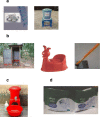WASH Benefits Bangladesh trial: system for monitoring coverage and quality in an efficacy trial
- PMID: 29976234
- PMCID: PMC6034300
- DOI: 10.1186/s13063-018-2708-2
WASH Benefits Bangladesh trial: system for monitoring coverage and quality in an efficacy trial
Abstract
Background: Researchers typically report more on the impact of public health interventions and less on the degree to which interventions were followed implementation fidelity. We developed and measured fidelity indicators for the WASH Benefits Bangladesh study, a large-scale efficacy trial, in order to identify gaps between intended and actual implementation.
Methods: Community health workers (CHWs) delivered individual and combined water, sanitation, handwashing (WSH) and child nutrition interventions to 4169 enrolled households in geographically matched clusters. Households received free enabling technologies (insulated water storage container; sani-scoop, potty, double-pit, pour-flush latrine; handwashing station, soapy-water storage bottle), and supplies (chlorine tablets, lipid-based nutrient supplements, laundry detergent sachets) integrated with parallel behavior-change promotion. Behavioral objectives were drinking treated, safely stored water, safe feces disposal, handwashing with soap at key times, and age-appropriate nutrition behaviors. We administered monthly surveys and spot-checks to households from randomly selected clusters for 6 months early in the trial. If any fidelity measures fell below set benchmarks, a rapid response mechanism was triggered.
Results: In the first 3 months, functional water seals were detected in 33% (14/42) of latrines in the sanitation only arm; 35% (14/40) for the combined WSH arm; and 60% (34/57) for the combined WSH and Nutrition arm, all falling below the pre-set benchmark of 80%. Other fidelity indicators met the 65 to 80% uptake benchmarks. Rapid qualitative investigations determined that households concurrently used their own latrines with broken water seals in parallel with those provided by the trial. In consultation with the households, we closed pre-existing latrines without water seals, increased the CHWs' visit frequency to encourage correct maintenance of latrines with water seals, and discouraged water-seal removal or breakage. At the sixth assessment, 86% (51/59) of households were in sanitation only; 92% (72/78) in the combined WSH; and 93% (71/76) in the combined WSH and Nutrition arms had latrines with functional water seals.
Conclusions: An intensive implementation fidelity monitoring and rapid response system proved beneficial for this efficacy trial. To implement a routine program at scale requires further research into an adaptation of fidelity monitoring that supports program effectiveness.
Trial registration: WASH Benefits Bangladesh: ClinicalTrials.gov, ID: NCT01590095 . Registered on 30 April 2012.
Keywords: Bangladesh; Behavior change; Child nutrition; Cluster randomized controlled trial; Efficacy; Handwashing; Implementation fidelity; Sanitation; WASH Benefits; Water quality.
Conflict of interest statement
Ethics approval and consent to participate
All households provided written informed consent at enrollment. The protocol was reviewed and approved by human subjects review committees at the International Centre for Diarrhoeal Disease Research, Bangladesh (icddr,b) and at the University of California, Berkeley.
Consent for publication
All co-authors have reviewed this version of the manuscript and provided consent for manuscript submission.
Competing interests
The authors declare that they have no competing interests.
Publisher’s Note
Springer Nature remains neutral with regard to jurisdictional claims in published maps and institutional affiliations.
Figures



References
-
- Proctor E, Silmere H, Raghavan R, Hovmand P, Aarons G, Bunger A, Griffey R, Hensley M. Outcomes for implementation research: conceptual distinctions, measurement challenges, and research agenda. Adm Policy Ment Health Ment Health Serv Res. 2011;38:65–76. doi: 10.1007/s10488-010-0319-7. - DOI - PMC - PubMed
Publication types
MeSH terms
Associated data
Grants and funding
LinkOut - more resources
Full Text Sources
Other Literature Sources
Medical
Miscellaneous

